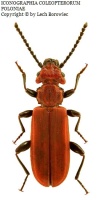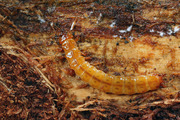
Русские, остановите эту войну! Спасите Свободную Украину!
Russians, stop this war! Save Free Ukraine!
Biodiversity Map
Taxa

Taxon count: 6
-
Cucujus cinnaberinus Set as tree root ↑
Show taxon data → ⚑
 [328] → Show taxon data
[328] → Show taxon data -
Cantharis sanguinolenta Set as tree root ↑
Show taxon data → → Show taxon data -
Cucujus cinnaberinus a. lechicus Set as tree root ↑
Show taxon data → → Show taxon data -
Cucujus depressus Set as tree root ↑
Show taxon data → → Show taxon data -
Cucujus geniculatus Set as tree root ↑
Show taxon data → → Show taxon data -
Meloe cinnaberinus Set as tree root ↑
Show taxon data → → Show taxon data
-
Arthropodaphylum
Click to switch
to select orders
and filters > -
Hexapodasubphylum
Click to switch
to select orders
and filters > -
Insectaclass
Click to switch
to select orders
and filters > -
Coleopteraorder
Click to set
as the main taxon
and as a base
← of the left panel > -
Polyphagasuborder
Click to set
as the main taxon
and as a base
← of the left panel > -
Cucujiformiaseries
Click to set
as the main taxon
and as a base
← of the left panel > -
Cucujoideasuperfamily
Click to set
as the main taxon
and as a base
← of the left panel > -
Cucujidaefamily
Click to set
as the main taxon
and as a base
← of the left panel > -
Cucujusgenus
Click to set
as the main taxon
and as a base
← of the left panel >
species:
Cucujus cinnaberinus
PL
YES
name status: valid name
BioMap ID: 1018333
taxon code: 3376
taxonomy checked: YES
protection form: ścisła, zakaz płoszenia, (Błąd nazwy gatunku w treści Rozporządzenia: "Cucujus cinnaberinnus")
Polish Red List: LC
Habitats Directive: Annex II, Annex IV
Data on distribution in Poland

Statistics
- Records: 328
- Publications: 33
- Collections: 6
- Publication authors: 27
- Illustrations (iconography): 1
- Photos (specimen/observation): 4
Taxon description
Gatunek obejmujący zasięgiem Europę północną oraz wschodnią część środkowej Europy, na południe docierający do górzystych, okolic w Jugosławii i Rumunii. W Polsce, pewne dane o jego występowaniu odnoszą się tylko do 6 krain południowych, wzmianki o występowaniu w Poznaniu i Warszawie opierają się prawdopodobnie na osobnikach zawleczonych z nieokorowanym drewnem z południowej części kraju. Zasiedla suche lub obumierające drzewa, głównie liściaste, rzadziej iglaste. Cykl rozwojowy, co najmniej dwuletni. Zarówno postacie dojrzałe, jak i larwy o ciele bardzo spłaszczonym żyją pod lekko odstającą korą drzew stojących lub leżących. Są one bardzo drapieżne i odżywiają się larwami i poczwarkami owadów podkorowych. Kopulacja i składanie jaj występuje w maju-czerwcu. Larwy po dwukrotnym przezimowaniu przepoczwarczają się w lipcu. Stadium poczwarki trwa około 10 dni. Młode chrząszcze wybarwiają się w ciągu 2-3 dni i pozostają aż do wiosny pod korą drzew lęgowych.
Illustrations
... browse
 Cucujus
Cucujuscinnaberinus
External data sources
- Ostatnie rekordy
-
1115740
 ⊡
⊡ Cucujidae: Cucujus cinnaberinus, PL, Beskid Wschodni, Pogórze Środkowobeskidzkie, Pogórze Jasielskie, podkarpackie, Jasło, 2014, leg. A. Taszakowski (Taszakowski et al. 2020)
Cucujidae: Cucujus cinnaberinus, PL, Beskid Wschodni, Pogórze Środkowobeskidzkie, Pogórze Jasielskie, podkarpackie, Jasło, 2014, leg. A. Taszakowski (Taszakowski et al. 2020) -
1111045
 ⊡
⊡ Cucujidae: Cucujus cinnaberinus, PL, Podkarpacie, Nizina Sandomierska, 2010, leg. J. Mazepa
Cucujidae: Cucujus cinnaberinus, PL, Podkarpacie, Nizina Sandomierska, 2010, leg. J. Mazepa -
1034800
 ⊡
⊡ Cucujidae: Cucujus cinnaberinus, PL, Góry Świętokrzyskie, Świętokrzyski P.N., świętokrzyskie, Kielce, 2013, leg. M.W. Kozłowski
Cucujidae: Cucujus cinnaberinus, PL, Góry Świętokrzyskie, Świętokrzyski P.N., świętokrzyskie, Kielce, 2013, leg. M.W. Kozłowski -
1034721
 ×
× Cucujidae: Cucujus cinnaberinus (2012e)
Cucujidae: Cucujus cinnaberinus (2012e) -
1031789
 ⊡
⊡ Cucujidae: Cucujus cinnaberinus, PL, Nizina Wielkopolsko-Kujawska, lubuskie, Słubice, rez. Łęgi koło Słubic, 2012
Cucujidae: Cucujus cinnaberinus, PL, Nizina Wielkopolsko-Kujawska, lubuskie, Słubice, rez. Łęgi koło Słubic, 2012 -
1031485
 ⊡
⊡ Cucujidae: Cucujus cinnaberinus, PL, Wyżyna Małopolska, mazowieckie, Radom m., 2012 (2012d)
Cucujidae: Cucujus cinnaberinus, PL, Wyżyna Małopolska, mazowieckie, Radom m., 2012 (2012d) -
922434
 ⊡
⊡ Cucujidae: Cucujus cinnaberinus, PL, Nizina Sandomierska, 2010, leg. J. Mazepa
Cucujidae: Cucujus cinnaberinus, PL, Nizina Sandomierska, 2010, leg. J. Mazepa -
781799
 ×
× Cucujidae: Cucujus cinnaberinus, PL, mazowieckie, Zgniotek w Nowym Dworze Mazowieckim, 2010, leg. J. Tatur-Dytkowski
Cucujidae: Cucujus cinnaberinus, PL, mazowieckie, Zgniotek w Nowym Dworze Mazowieckim, 2010, leg. J. Tatur-Dytkowski -
781754
 ×
× Cucujidae: Cucujus cinnaberinus, PL, mazowieckie, Zgniotek w Nowym Dworze Mazowieckim, 2009, leg. J. Tatur-Dytkowski
Cucujidae: Cucujus cinnaberinus, PL, mazowieckie, Zgniotek w Nowym Dworze Mazowieckim, 2009, leg. J. Tatur-Dytkowski -
774163
 ⊡
⊡ Cucujidae: Cucujus cinnaberinus, PL, Pojezierze Pomorskie, 1991, leg. L. Borowiec, coll. Uniw. Wrocławski, ZBiTE
Cucujidae: Cucujus cinnaberinus, PL, Pojezierze Pomorskie, 1991, leg. L. Borowiec, coll. Uniw. Wrocławski, ZBiTE - ... more
- Powiązane publikacje
-
Taszakowski A., Kaszyca-Taszakowska N., Szczepański W.T., Karpiński L. 2020. New Data on Little-known Beetle Families and a Summary of the Project: Coleoptera of the Eastern Beskid Mts (Western Carpathians, Poland). J. Entomol. Res. Soc., 22(1):13-40.
 Show records
Show records -
Smolis A., Kadej M., Gutowski J.M., Ruta R., Matraj M. 2012e. Zgniotek cynobrowy Cucujus cinnaberinus (Scopoli, 1763) (Insecta: Coleoptera: Cucujidae) – rozmieszczenie, ekologia i problemy ochrony oraz nowe stanowiska w Polsce południowo-zachodniej. , 68(5):332-346.
 Show records
Show records -
Miłkowski M. 2012d. Zgniotek cynobrowy Cucujus cinnaberinus (Scopoli, 1763) (Coleoptera: Cucujidae) w Radomiu. Kulon, 17:139-141.
 Show records
Show records -
Plewa R., Hilszczański J., Jaworski T. 2011a. New records of some rare saproxylic beetles (Coleoptera) in Poland. Nature Journal, 44:120-131.
 Show records
Show records -
Byk A., Mokrzycki T., Perliński S., Rutkiewicz A. 2006. Saproxylic beetles – in the monitoring of anthropogenic transformations of Białowieża Primeval Forest. [In:] Szujecki A. (Ed.) Zooindication-based monitoring of anthropogenic transformations in Białowieża Primeval Forest. Warsaw Agricultural University Press, Warsaw. pp. 325-397.
 Show records
Show records - ... more







